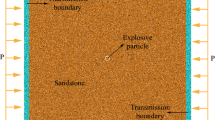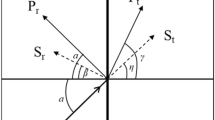Abstract
The expected blasting effect of rock mass is always affected by the soft-hard rock strata with anisotropic mechanical properties, especially under the influence of in-situ stress. Based on discrete element method (PFC2D), single-hole blasting experiments are carried out considering effect of soft-hard rock strata and in-situ stress. The result is analyzed from the perspectives of cracks state, cracks number, cracks extension range and energy fields. The results show that: 1) Under different in-situ stress fields, damage degree of rock mass increases first, then decreases rapidly and ultimately keeps stable with growth of soft rock thickness. Through fitting, better change laws are obtained. 2) When detonation in hard rock, if distance between blasthole and structural plane is larger than about 4 times the radius of crushing area, cracks development is restrained with the growth of in-situ stress. 3) Rock damage degree of rock firstly ascends and then descends with growth of Uniaxial Compressive Strength (UCS). Rock damage degree reaches maximum at about 40 MPa and descends with growth of in-situ stress, when it is greater than about 80 MPa. 4) When detonation in hard rock and lower in-situ stress, if structural plane is outside crushing area, peak kinetic energy will decrease with the growth of in-situ stress as well as peak friction energy, which is contrary to the peak strain energy.
Similar content being viewed by others
Abbreviations
- A :
-
Cross section area of contact
- C P :
-
P-wave velocity
- C S :
-
S-wave velocity
- E F :
-
Friction energy
- E K :
-
inetic energy
- E S :
-
Strain energy
- F :
-
Sum of external force
- F b :
-
Particle force at the boundary
- F d :
-
Fashpot force
- \(\overline {{F_n}} \) :
-
Normal force of the contact
- \(\overline {{F_s}} \) :
-
Tangential force of the contact
- g :
-
Acceleration of body force
- I :
-
Moment of inertia
- J :
-
Polar moment of inertia
- k n :
-
Normal stiffness
- k s :
-
Shear stiffness
- L :
-
Angular momentum
- m i :
-
Mass of the particle
- M b :
-
Bending moment
- M t :
-
Twisting moment
- n :
-
Particles number
- p(t):
-
Explosion pressure
- P max :
-
Maximum of detonation pressure
- \(\overline R \) :
-
Radius of the bond
- t :
-
Blasting process time
- \({{\dot u}_n}\) :
-
Normal velocity of the particle
- \({{\dot u}_s}\) :
-
Tangential velocity of the particle
- v i :
-
Velocity of the particle
- ẍ:
-
Acceleration of particle
- \({\dot \delta}\) :
-
Relative translation velocity
- ΔT :
-
Sum of loading and unloading time
- η :
-
Dispersion effect correction coefficients of S-wave
- σ t max :
-
Maximum of normal stress
- τ max :
-
Maximum of shear stress
- ω :
-
Angular velocity
- ζ :
-
Dispersion effect correction coefficients of P-wave
References
Aliabadian Z, Sharafisafa M, Mortazavi A, Maarefvand P (2014) Wave and fracture propagation in continuum and faulted rock masses: Distinct element modeling. Arabian Journal of Geosciences 7(12): 5021–5035, DOI: https://doi.org/10.1007/s12517-013-1155-3
Babanouri N, Fattahi H (2018) Evaluating orthotropic continuum analysis of stress wave propagation through a jointed rock mass. Bulletin of Engineering Geology and the Environment 77(2):725–733, DOI: https://doi.org/10.1007/s10064-016-0989-9
Chen L, Fan S, Zhao C, Zhang L, Cheng Z (2019) Calculation method of overburden damage height based on fracture mechanics analysis of soft and hard rock layers. Geofluids 2019:3790264, DOI: https://doi.org/10.1155/2019/3790264
Cui J, Xie L, Qiao W, Qiu L, Hu Z, Wu L (2022) Study on blasting characteristics of rock mass with weak interlayer based on energy field. Scientific Reports 12(1):12698, DOI: https://doi.org/10.1038/s41598-022-17028-y
Cundall PA, Strack ODL (1979) A discrete numerical model for granular assemblies. Géotechnique 29(1):47–65, DOI: https://doi.org/10.1680/geot1979.29.1.47
Deng X, Zhu J, Chen S, Zhao J (2012) Some fundamental issues and verification of 3DEC in modeling wave propagation in jointed rock masses. Rock Mechanics and Rock Engineering 45(5):943–951, DOI: https://doi.org/10.1007/s00603-012-0287-1
Dong Q, Li X, Jia X, Sun J (2021) A numerical simulation of blasting stress wave propagation in a jointed rock mass under initial stresses. Applied Sciences-Basel 11(17):7873, DOI: https://doi.org/10.3390/app11177873
Dong M, Wang L, Shahbodagh B, Du X, Deng S, Sun Z (2020) Effect of the soft and hard interbedded layers of bedrock on the mechanical characteristics of stabilizing piles. Applied Sciences-Basel 10(14):4760, DOI: https://doi.org/10.3390/app10144760
Feng X, Zhang Q, Wang E, Ali M, Dong Z, Zhang G (2020) 3D modeling of the influence of a splay fault on controlling the propagation of nonlinear stress waves induced by blast loading. Soil Dynamics and Earthquake Engineering 138:106335, DOI: https://doi.org/10.1016/j.soildyn.2020.106335
Gao K, Huang P, Liu Z, Liu J, Shu C, Qiao G (2021) Coal—rock damage characteristics caused by blasting within a reverse fault and its resultant effects on coal and gas outburst. Scientific Reports 11(1):19158, DOI: https://doi.org/10.1038/s41598-021-98581-w
Jia S, Wang Z, Wang J, Lu Z, Wang H (2021) Experimental and theoretical study on the propagation characteristics of stress wave in filled jointed rock mass. PloS One 16(9):e0253392, DOI: https://doi.org/10.1371/journal.pone.0253392
Kotrocz K, Mouazen AM, Kerényi G (2016) Numerical simulation of soil-cone penetrometer interaction using discrete element method. Computers and Electronics in Agriculture 125:63–73, DOI: https://doi.org/10.1016/j.compag.2016.04.023
Li H, Liu T, Liu Y, Li J, Xia X, Liu B (2016) Numerical modeling of wave transmission across rock masses with nonlinear joints. Rock Mechanics and Rock Engineering 49(3):1115–1121, DOI: https://doi.org/10.1007/s00603-015-0766-2
Li N, Ma Z, Gong P, Qi F, Wang T, Cheng S (2020) Simulation research on the load transfer mechanism of anchoring system in soft and hard composite rock strata under tensile loading conditions. Advances in Materials Science and Engineering 2020:9097426, DOI: https://doi.org/10.1155/2020/9097426
Li J, Ma G, Zhao J (2011) Analysis of stochastic seismic wave interaction with a slippery rock fault. Rock Mechanics and Rock Engineering 44(1):85–92, DOI: https://doi.org/10.1007/s00603-010-0109-2
Li Y, Yashi L, Rui Z, Jianbo Z (2020) Experimental study of blasting wave propagation in jointed rock mass and vibration reduction effect of barrier holes. IOP Conference Series: Earth and Environmental Science 570:042026, DOI: https://doi.org/10.1088/1755-1315/570/4/042026
Liu C, Zhang J, Cui P (2018) Energy evolution and stress response during stress wave prorogation in the intercalation. Rock and Soil Mechanics 39(6):2267–2277, DOI: https://doi.org/10.16285/j.rsm.2016.1836
Resende R, Lamas LN, Lemos JV, Calçada R (2010) Micromechanical modelling of stress waves in rock and rock fractures. Rock Mechanics and Rock Engineering 43(6):741–761, DOI: https://doi.org/10.1007/s00603-010-0098-1
Sainoki A, Mitri HS (2016) Dynamic modelling of fault slip induced by stress waves due to stope production blasts. Rock Mechanics and Rock Engineering 49(1):165–181, DOI: https://doi.org/10.1007/s00603-015-0721-2
Shi C, Zhang Q, Wang S (2018) Numerical simulation technology and application with particle flow code (PFC5.0). Publisher: China Architecture Industry Press, China, 2018, http://refhub.elsevier.com/S1569-190X(20)30058-7/sbref0020
Sun N, Lei M, Zhang Y, Su G, Huang G (2020) A study on the influence of weak interlayer on the propagation process of explosion stress wave. Journal of Vibration and Shock 39(16):112–119+147, DOI: https://doi.org/10.13465/j.cnki.jvs.2020.16.016
Sun X, Li G, Zhao C, Liu Y, Miao C (2018) Investigation of deep mine shaft stability in alternating hard and soft rock strata using three-dimensional numerical modeling. Processes 7(1):2, DOI: https://doi.org/10.3390/pr7010002
Wang G, Wang X, Hu S (2015) A dynamic measurement method of elastic modulus of weak interlayer of rock mass. Chinese Journal of Rock Mechanics and Engineering 34(9):1828–1835, DOI: https://doi.org/10.13722/j.cnki.jrme.2014.0873
Wang Y, Zhang Y, Zhu Z, Du M, Qi Y (2020) A novel method for analyzing the factors influencing ground settlement during shield tunnel construction in upper-soft and lower-hard fissured rock strata considering the coupled hydromechanical properties. Geofluids 2020:6691157, DOI: https://doi.org/10.1155/2020/6691157
Xie L, Zhu Q, Qin Y, Wang J, Qian J (2020) Study on evolutionary characteristics of toppling deformation of anti-dip bank slope based on energy field. Sustainability 12(18):7544, DOI: https://doi.org/10.3390/su12187544
Yuan W, Wang W, Su X, Li J, Li Z, Wen L, Chang J (2018) Numerical study of the impact mechanism of decoupling charge on blasting-enhanced permeability in low-permeability sandstones. International Journal of Rock Mechanics and Mining Sciences 106:300–310, DOI: https://doi.org/10.1016/j.ijrmms.2018.04.029
Zeng S, Wang S, Sun B, Liu Q (2018) Propagation characteristics of blasting stress waves in layered and jointed rock caverns. Geotechnical and Geological Engineering 36(3):1559–1573, DOI: https://doi.org/10.1007/s10706-017-0410-x
Zhou H, He C (2020) Propagation law of stress wave and cracks in non-penetrating jointed rock mass: A numerical study based on particle flow code. Geotechnical and Geological Engineering 38(4):3967–3981, DOI: https://doi.org/10.1007/s10706-020-01271-z
Zhu G, Dou L, Liu Y, Su Z, Li H, Kong Y, Li Z (2016) Dynamic behavior of fault slip induced by stress waves. Shock and Vibration 2016:4386836, DOI: https://doi.org/10.1155/2016/4386836
Zhu J, Perino A, Zhao G, Barla G, Li J, Ma G, Zhao J (2011) Seismic response of a single and a set of filled joints of viscoelastic deformational behaviour. Geophysical Journal International 186(3):1315–1330, DOI: https://doi.org/10.1111/j.1365-246X.2011.05110.x
Acknowledgements
This project was supported by the National Natural Science Foundation of China (52068066,51908482), Autonomous Region Graduate Scientific Research Innovation Project (XJ2022G050) and Science and Technology Research and Development Project of CSCEC (CSCEC-2020-Z-56).
Author information
Authors and Affiliations
Corresponding author
Rights and permissions
About this article
Cite this article
Cui, J., Xie, L., Qin, Y. et al. Study on Blasting Characteristics of Shallow and Deep Soft-hard Rock Strata Based on Energy Field. KSCE J Civ Eng 27, 1942–1954 (2023). https://doi.org/10.1007/s12205-023-0494-1
Received:
Revised:
Accepted:
Published:
Issue Date:
DOI: https://doi.org/10.1007/s12205-023-0494-1




